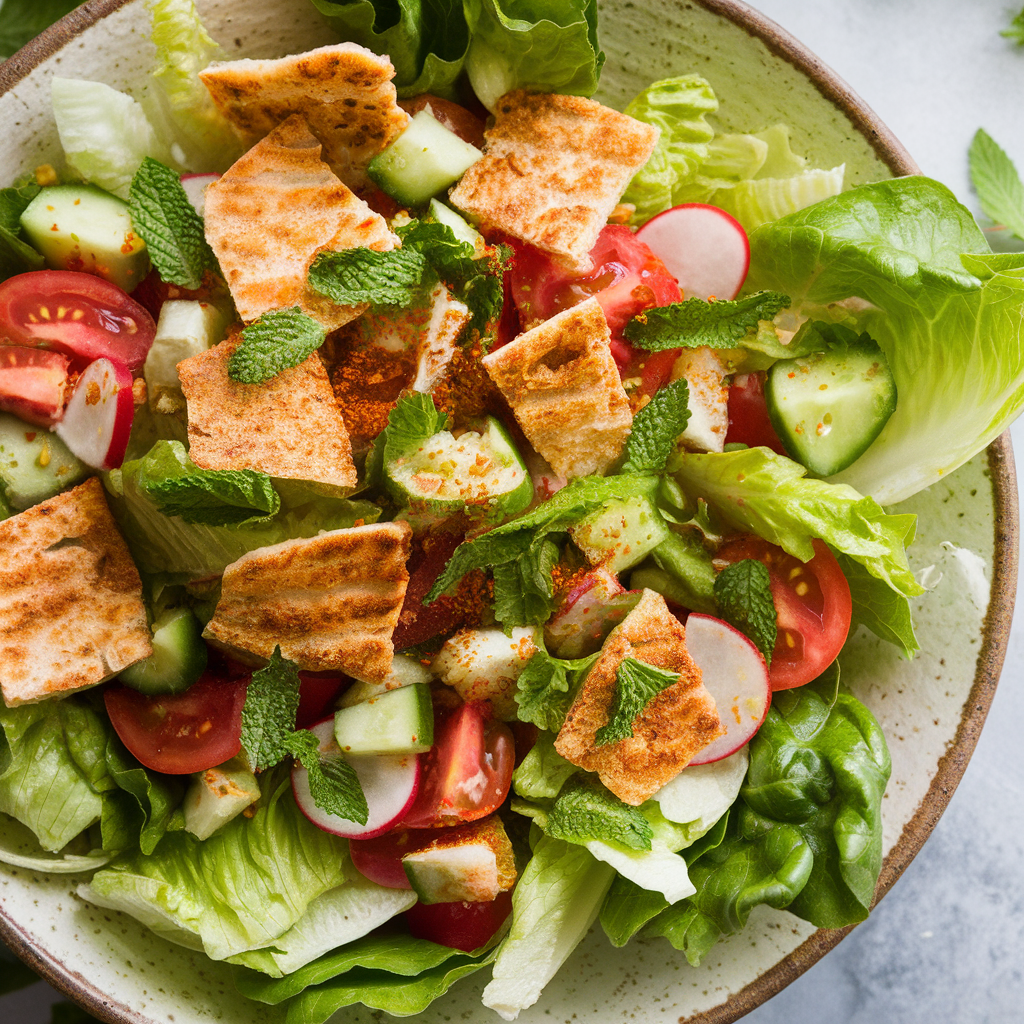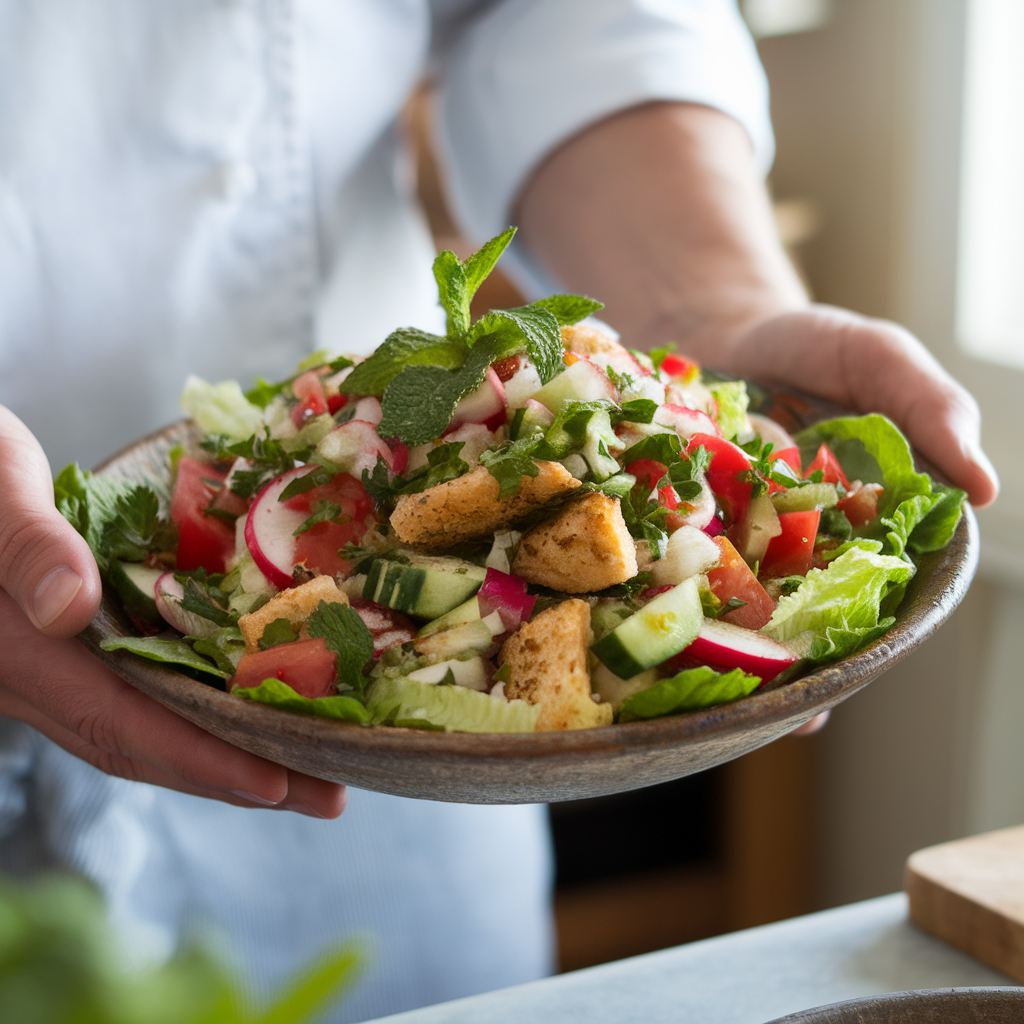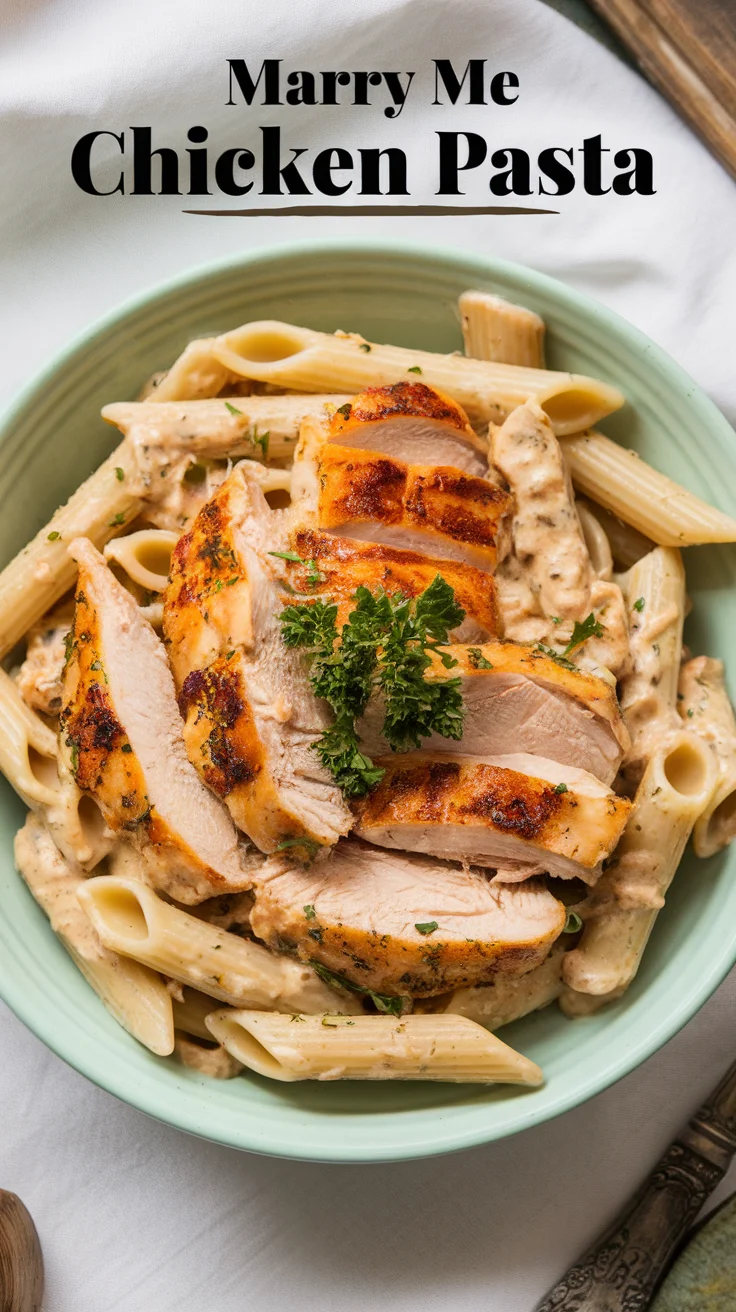Lebanese cuisine is renowned for its vibrant flavors, fresh ingredients, and balanced dishes that combine health with taste. Among its celebrated dishes, Fattoush Lebanese bread salad shines as a timeless classic—a colorful, crunchy salad that perfectly complements grilled meats and acts as a refreshing counterpoint to rich meals. Whether served alongside succulent Lebanese kabobs, featured at a traditional Lebanese recipes dinner, or enjoyed with creative Lebanese BBQ ideas, fattoush embodies the heart and soul of Lebanese home cooking.
This guide explores every aspect of fattoush—its origins, ingredients, preparation, variations, nutritional benefits, and how it fits within Arabic side dishes, Lebanese vegetable recipese Lebanese side dish recipes. If you want to master this iconic salad or elevate your Lebanese meals, read on for a full immersion into fattoush.
Origins and Cultural Significance: Why Fattoush Is a Lebanese Culinary Treasure
Fattoush (فتوش) traces back centuries in the Levant region, a cultural area spanning modern-day Lebanon, Syria, Jordan, and Palestine. The dish’s name comes from the Arabic root “fatt,” meaning “to break” or “crumble,” referencing the signature toasted or fried pieces of pita bread incorporated into the salad.
Historically, fattoush emerged as a practical, resourceful way to use stale pita bread. Rather than waste bread, Lebanese cooks combined it with fresh seasonal vegetables and herbs, tossed in a tangy dressing to create a lively, crunchy salad. Over time, fattoush evolved from humble home kitchens to restaurant tables, becoming a staple in Lebanese mezze—a spread of small plates designed for sharing and socializing.
Today, fattoush is celebrated not only in Lebanon but across the globe, appreciated for its freshness, simplicity, and versatility. It perfectly illustrates how Lebanese cuisine balances textures and flavors to create memorable meals.
The Essential Ingredients: Building Blocks of Authentic Fattoush
What makes fattoush so irresistible? The magic lies in its combination of fresh vegetables, aromatic herbs, tangy dressing, and crunchy pita. Let’s break down each key ingredient:
Arabic Bread (Pita)
- Traditionally, pita bread is slightly stale to ensure it crisps up nicely when toasted or fried.
- Cut into triangles or bite-sized pieces, it’s toasted in an oven or fried in oil until golden brown and crunchy.
- The crispy pita adds an essential texture contrast to the tender vegetables and tangy dressing.
- Modern variations may substitute gluten-free pita or other flatbreads to accommodate dietary preferences.
Fresh Lebanese Vegetables
- Cucumbers: Crisp and hydrating, cucumbers are diced to provide a cooling effect.
- Tomatoes: Juicy and sweet, they add color and moisture.
- Radishes: Their peppery bite enhances the salad’s complexity.
- Bell Peppers: Provide sweetness and crunch.
- Green Onions: Impart mild onion flavor without overpowering.
- Fresh Herbs: Parsley and mint leaves are finely chopped, offering aromatic freshness and green vibrancy.
- Seasonal vegetables may also be incorporated, making fattoush a truly adaptable salad.

The Signature Lebanese Dressing
- The dressing is a zesty vinaigrette, anchored by fresh lemon juice, extra virgin olive oil, and the hallmark spice—sumac.
- Sumac is a reddish-purple spice ground from dried sumac berries, with a tangy, lemony flavor that defines fattoush’s taste.
- Often enhanced with garlic, salt, pepper, and sometimes a touch of pomegranate molasses for sweetness and depth.
- This dressing ties the salad together, coating each ingredient in vibrant, citrusy goodness.
Step-by-Step Fattoush Recipe: How to Prepare an Authentic Lebanese Bread Salad
Step 1: Toast or Fry the Pita Bread
- Preheat the oven to 350°F (175°C).
- Cut 2-3 pita breads into bite-sized triangles or strips.
- Lightly toss with olive oil and spread in a single layer on a baking sheet.
- Bake for 10-15 minutes until golden and crisp, turning halfway.
- Alternatively, fry the pieces in hot oil for 1-2 minutes until puffed and golden; drain on paper towels.
- Set aside to cool.
Step 2: Chop the Fresh Vegetables and Herbs
- Dice 2 large cucumbers (keeping skin on for crunch).
- Chop 3-4 ripe tomatoes into small chunks.
- Thinly slice 6-8 radishes for peppery sharpness.
- Chop 2 green or red bell peppers finely.
- Slice 3-4 green onions thinly.
- Finely chop a generous handful each of fresh parsley and mint.
Step 3: Prepare the Lebanese Dressing
In a bowl, whisk together:
- 3 tablespoons freshly squeezed lemon juice
- 3 tablespoons extra virgin olive oil
- 1 teaspoon sumac (adjust to taste)
- 1 tablespoon pomegranate molasses (optional but recommended)
- 1 small garlic clove, minced (optional)
- Salt and freshly ground black pepper to taste
Step 4: Combine and Toss
- Place the chopped vegetables and herbs in a large salad bowl.
- Add the crispy pita bread pieces.
- Pour the dressing over the salad.
- Toss gently to combine without breaking the pita bread too much.
- Serve immediately to preserve the pita’s crunch.

Why Fattoush Is an Essential Arabic Side Dish and Lebanese Vegetable Recipe
Fattoush is more than just a salad—it’s a fundamental part of Lebanese culinary identity and a perfect example of how Lebanese vegetable recipes shine as standalone dishes or side accompaniments.
- It balances richness with freshness and crunch with tenderness.
- Acts as a natural palate cleanser between bites of rich Lebanese kabobs or grilled meats.
- Is often served alongside other mezze dishes such as hummus, baba ghanoush, and tabbouleh to create a vibrant dining experience.
- Fits beautifully into modern healthy eating due to its nutrient-rich, plant-based ingredients.
- Its tangy, aromatic dressing is quintessentially Lebanese and elevates the salad beyond a simple vegetable mix.
Variations and Creative Twists on the Classic Fattoush Recipe
While traditional fattoush is simple and pure, numerous variations allow for creativity:
- Add Romaine or Arugula: For extra leafy greens and volume.
- Include Pomegranate Seeds: Add bursts of sweet juiciness and beautiful color.
- Top with Toasted Nuts or Seeds: Pine nuts, walnuts, or sesame seeds add richness and crunch.
- Spice It Up: Sprinkle Aleppo pepper or chili flakes for warmth.
- Protein Addition: Add grilled chicken or chickpeas to turn fattoush into a main meal.
- Sem Glúten: Use gluten-free pita or omit bread altogether for a fresh vegetable salad.
- Add Avocado: For creaminess and richness.
Pairing Fattoush with Lebanese Kabobs and BBQ Ideas
No Lebanese feast is complete without grilled meats, and fattoush is the perfect partner:
- Serve fattoush alongside chicken kabobs marinated in garlic, lemon, and spices, balancing the savory smoky flavors with its zesty crunch.
- Pair with beef or lamb kabobs, where fattoush’s acidity cuts through rich, fatty meats.
- Combine with other Lebanese BBQ ideas like grilled halloumi, kafta, or shrimp skewers.
- Use fattoush as a fresh side in mezze platters, along with dips like hummus and baba ghanoush.
Health Benefits of Fattoush: A Nutritional Powerhouse
Fattoush isn’t just delicious — it’s packed with nutrition:
- High in fiber and vitamins from fresh vegetables and herbs.
- Rich in antioxidants, particularly from sumac and parsley.
- Healthy fats from olive oil help reduce inflammation and improve heart health.
- Low in calories but filling, making it ideal for weight management.
- Easily adaptable for gluten-free, vegan, and vegetarian diets.

How to Incorporate Fattoush into Your Meal Plan
Fattoush’s versatility makes it suitable for numerous occasions:
- As a refreshing side dish with grilled meats or roasted dishes.
- Part of a mezze spread for gatherings.
- A light lunch when topped with grilled chicken or beans.
- A vibrant accompaniment to sandwiches or wraps.
- An easy make-ahead dish if bread is toasted just before serving.
Frequently Asked Questions About Fattoush
Can I make fattoush ahead?
Prepare vegetables and dressing separately and add pita just before serving to keep bread crunchy.
Is sumac essential?
Yes, sumac defines the classic tangy flavor but can be replaced with extra lemon juice if unavailable.
What if I don’t have pita bread?
You can use toasted flatbreads or gluten-free alternatives.
More Arabic Side Dishes and Lebanese Side Dish Recipes to Explore
Complement fattoush with these traditional dishes:
- Tabbouleh: Parsley and bulgur salad.
- Hummus: Chickpea and tahini dip.
- Baba Ghanoush: Smoky eggplant dip.
- Labneh: Creamy strained yogurt.
- Stuffed Grape Leaves (Warak Enab): Grape leaves stuffed with rice and herbs.
Together, they create a complete, balanced Lebanese meal.
Final Thoughts: Celebrate Lebanese Flavors with Fattoush
O Fattoush recipe is a shining example of Lebanese culinary artistry — fresh ingredients, bold flavors, and textural harmony. It’s an essential Lebanese side dish recipe, especially when enjoyed alongside Lebanese kabobs or grilled meats at a lively dinner.
Bringing this salad to your table not only introduces authentic Lebanese tastes but also adds vibrant colors and healthy nutrition. Whether you’re hosting a Lebanese-themed meal or looking for exciting ways to enjoy Lebanese vegetables, fattoush is a must-have dish that everyone will love.


